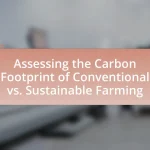Biodegradable mulches are organic materials utilized in agriculture and gardening that naturally decompose over time, enhancing soil health and reducing reliance on synthetic plastics. This article explores the composition, benefits, and environmental advantages of biodegradable mulches, highlighting their effectiveness in weed suppression compared to traditional plastic options. It also addresses the challenges associated with their use, including degradation rates and climate impacts, while providing best practices for implementation and troubleshooting common issues. Overall, biodegradable mulches present a sustainable alternative for effective weed control and improved agricultural practices.

What are Biodegradable Mulches?
Biodegradable mulches are organic materials used in agriculture and gardening that decompose naturally over time, enriching the soil. These mulches, made from substances like corn starch, paper, or plant residues, serve multiple purposes, including weed suppression, moisture retention, and soil temperature regulation. Research indicates that biodegradable mulches can improve soil health and reduce the need for synthetic plastic alternatives, which contribute to environmental pollution. Studies have shown that using biodegradable options can lead to enhanced crop yields while minimizing ecological impact, making them a sustainable choice for weed control.
How do Biodegradable Mulches differ from traditional mulches?
Biodegradable mulches differ from traditional mulches primarily in their composition and environmental impact. Biodegradable mulches are made from organic materials such as plant residues, starches, or other natural substances that decompose over time, enriching the soil and reducing waste. In contrast, traditional mulches often consist of synthetic materials like plastic, which do not break down and can contribute to soil pollution and environmental degradation. Research indicates that biodegradable mulches can improve soil health and reduce the need for chemical herbicides, making them a more sustainable option for weed control.
What materials are commonly used in Biodegradable Mulches?
Common materials used in biodegradable mulches include corn starch, wheat straw, rice hulls, and paper products. These materials are chosen for their ability to decompose naturally in the soil, providing nutrients to plants while suppressing weed growth. For instance, corn starch-based mulches break down into organic matter, enhancing soil quality, while wheat straw and rice hulls offer effective weed control and moisture retention. Studies have shown that these biodegradable options can significantly reduce the need for synthetic mulches, promoting sustainable agricultural practices.
How do the decomposition processes of Biodegradable Mulches work?
Biodegradable mulches decompose through microbial activity, which breaks down the organic materials into simpler compounds. This process begins when microorganisms, such as bacteria and fungi, colonize the mulch, utilizing it as a food source. As they metabolize the organic matter, they produce enzymes that facilitate the breakdown of complex polymers into smaller molecules. Environmental factors like temperature, moisture, and oxygen availability significantly influence the rate of decomposition. For instance, studies have shown that higher temperatures and adequate moisture levels accelerate microbial activity, leading to faster degradation. The end products of this decomposition process are typically carbon dioxide, water, and nutrient-rich organic matter, which can enhance soil fertility.
Why are Biodegradable Mulches considered sustainable?
Biodegradable mulches are considered sustainable because they decompose naturally, enriching the soil without leaving harmful residues. This decomposition process reduces the need for synthetic plastic mulches, which contribute to environmental pollution and soil degradation. Studies indicate that biodegradable mulches can improve soil health by enhancing microbial activity and nutrient availability, thus promoting sustainable agricultural practices. Additionally, their use aligns with eco-friendly farming methods, supporting biodiversity and reducing carbon footprints associated with traditional plastic waste.
What environmental benefits do Biodegradable Mulches provide?
Biodegradable mulches provide significant environmental benefits, including reduced plastic pollution and improved soil health. These mulches decompose naturally, minimizing the accumulation of synthetic waste in landfills and ecosystems. Research indicates that biodegradable mulches can enhance soil moisture retention and promote beneficial microbial activity, which contributes to healthier plant growth. Additionally, studies show that using biodegradable materials can reduce the need for chemical herbicides, leading to less chemical runoff into waterways, thereby protecting aquatic ecosystems.
How do Biodegradable Mulches contribute to soil health?
Biodegradable mulches contribute to soil health by enhancing soil structure, improving moisture retention, and promoting microbial activity. These mulches decompose over time, adding organic matter to the soil, which increases its fertility and nutrient availability. Research indicates that the incorporation of biodegradable materials can lead to a significant increase in soil organic carbon levels, which is essential for maintaining soil health and productivity. Additionally, studies have shown that biodegradable mulches can suppress weed growth while simultaneously fostering beneficial soil organisms, thus creating a balanced ecosystem that supports plant growth.

What are the advantages of using Biodegradable Mulches for weed control?
Biodegradable mulches offer several advantages for weed control, primarily their ability to suppress weed growth while decomposing naturally. These mulches create a physical barrier that blocks sunlight, preventing weed germination and growth. Additionally, as they break down, they enrich the soil with organic matter, improving soil health and structure. Research indicates that biodegradable mulches can reduce the need for chemical herbicides, promoting an environmentally friendly approach to agriculture. Studies have shown that using biodegradable materials can lead to effective weed suppression rates comparable to traditional plastic mulches, while also contributing to sustainable farming practices.
How effective are Biodegradable Mulches in suppressing weeds?
Biodegradable mulches are highly effective in suppressing weeds, often achieving similar or better results compared to traditional plastic mulches. Research indicates that biodegradable mulches can reduce weed biomass by up to 90% during the growing season, as they create a physical barrier that limits light penetration and inhibits weed seed germination. Studies, such as those conducted by the University of California, demonstrate that these mulches not only suppress weeds but also improve soil moisture retention and enhance soil health as they decompose.
What factors influence the effectiveness of Biodegradable Mulches against weeds?
The effectiveness of biodegradable mulches against weeds is influenced by factors such as material composition, thickness, degradation rate, environmental conditions, and application method. Material composition affects the mulch’s ability to suppress weed growth; for instance, mulches made from corn starch or paper may decompose faster than those made from wood fibers, impacting their longevity and effectiveness. Thickness plays a crucial role, as thicker layers generally provide better weed suppression by blocking light. The degradation rate is also significant; faster-decomposing mulches may require more frequent replacement, reducing their overall effectiveness. Environmental conditions, including temperature, moisture, and soil type, can affect both the mulch’s performance and the growth of weeds. Lastly, the application method, such as how well the mulch is spread and its contact with the soil, can determine its ability to control weeds effectively.
How do Biodegradable Mulches compare to chemical herbicides?
Biodegradable mulches are generally considered a more environmentally friendly alternative to chemical herbicides for weed control. Unlike chemical herbicides, which can contaminate soil and water and harm non-target organisms, biodegradable mulches decompose naturally, enriching the soil and promoting beneficial microbial activity. Research indicates that biodegradable mulches can effectively suppress weed growth while providing additional benefits such as moisture retention and temperature regulation in the soil. Studies have shown that using biodegradable materials can reduce the reliance on synthetic chemicals, thereby minimizing ecological risks associated with herbicide application.
What are the economic benefits of using Biodegradable Mulches?
Biodegradable mulches provide significant economic benefits by reducing labor costs and improving crop yields. These mulches eliminate the need for plastic disposal, which can incur additional expenses, and they enhance soil health, leading to better plant growth and higher productivity. Research indicates that using biodegradable mulches can increase crop yields by up to 20% compared to traditional methods, resulting in greater revenue for farmers. Additionally, the reduction in herbicide usage associated with biodegradable mulches can lead to cost savings, as farmers spend less on chemical inputs.
How do Biodegradable Mulches impact labor costs in agriculture?
Biodegradable mulches reduce labor costs in agriculture by minimizing the need for manual weeding and enhancing soil moisture retention. Studies indicate that the use of biodegradable mulches can decrease weeding labor by up to 50%, as they effectively suppress weed growth while decomposing into the soil. This reduction in labor not only lowers costs but also allows farmers to allocate resources to other critical tasks, thereby improving overall operational efficiency.
What is the long-term cost-effectiveness of Biodegradable Mulches?
The long-term cost-effectiveness of biodegradable mulches is generally favorable compared to traditional plastic mulches. Studies indicate that while the initial investment in biodegradable mulches may be higher, the reduction in labor costs for weed management and the elimination of disposal costs associated with plastic mulches contribute to overall savings. For instance, research published in the journal “Agricultural Systems” found that biodegradable mulches can lead to a 20-30% reduction in total weed management costs over multiple growing seasons. Additionally, the environmental benefits, such as improved soil health and reduced plastic pollution, further enhance their value in sustainable agricultural practices.

What challenges are associated with Biodegradable Mulches?
Biodegradable mulches face several challenges, including inconsistent degradation rates, potential nutrient immobilization, and limited availability of suitable materials. Inconsistent degradation can lead to premature breakdown or prolonged persistence in the soil, affecting weed control efficacy. Nutrient immobilization occurs when the decomposition of organic materials temporarily reduces nutrient availability for plants, potentially impacting crop growth. Additionally, the market for biodegradable mulches is still developing, which can limit access to high-quality products that meet specific agricultural needs.
What limitations do Biodegradable Mulches have in different climates?
Biodegradable mulches have limitations that vary significantly across different climates, primarily due to their degradation rates and effectiveness in moisture retention. In hot and arid climates, biodegradable mulches may decompose too quickly, failing to provide adequate weed control and soil moisture retention. Conversely, in cooler and wetter climates, these mulches may not degrade sufficiently, leading to potential accumulation and hindering soil aeration and plant growth. Research indicates that the degradation of biodegradable materials is influenced by temperature, moisture, and microbial activity, which differ widely across climatic zones. For instance, a study published in the journal “Agricultural Sciences” found that the degradation rate of biodegradable mulches can be up to 50% faster in warm, dry conditions compared to cool, moist environments.
How do moisture levels affect the performance of Biodegradable Mulches?
Moisture levels significantly influence the performance of biodegradable mulches by affecting their degradation rate and effectiveness in weed suppression. High moisture levels can accelerate the breakdown of biodegradable materials, leading to a shorter lifespan and reduced effectiveness in controlling weeds. Conversely, low moisture levels may slow down the degradation process, allowing the mulch to persist longer but potentially reducing its ability to suppress weeds effectively. Research indicates that optimal moisture conditions enhance the microbial activity responsible for the decomposition of biodegradable mulches, thus balancing their longevity and weed control capabilities.
What are the potential issues with the quality of Biodegradable Mulches?
Potential issues with the quality of biodegradable mulches include inconsistent degradation rates, contamination with non-biodegradable materials, and variability in material composition. Inconsistent degradation rates can lead to premature breakdown or prolonged presence in the soil, affecting weed control efficacy. Contamination with non-biodegradable materials, such as plastics, can undermine the environmental benefits of biodegradable options. Additionally, variability in material composition, often due to differences in manufacturing processes, can result in inconsistent performance and durability, impacting their effectiveness as a sustainable alternative for weed control.
How can users effectively implement Biodegradable Mulches?
Users can effectively implement biodegradable mulches by selecting the appropriate type based on their specific gardening needs, preparing the soil adequately, and applying the mulch at the right thickness. For instance, users should choose materials like straw, wood chips, or paper that decompose at a suitable rate for their plants. Proper soil preparation involves removing weeds and leveling the surface to ensure good contact between the mulch and soil. Applying a layer of 2 to 4 inches of mulch helps suppress weeds while allowing moisture to penetrate. Studies indicate that biodegradable mulches can improve soil health and reduce the need for chemical herbicides, making them a sustainable choice for weed control.
What best practices should be followed when applying Biodegradable Mulches?
When applying biodegradable mulches, it is essential to ensure proper soil preparation and moisture management. Proper soil preparation involves clearing the area of weeds and debris, followed by leveling the soil to promote even mulch application. Moisture management is crucial, as biodegradable mulches require adequate moisture to break down effectively; therefore, applying them when the soil is moist enhances their performance.
Additionally, it is important to apply the mulch at the correct thickness, typically 2 to 4 inches, to suppress weeds while allowing water and nutrients to reach the soil. Regular monitoring of the mulch’s condition is necessary to determine if replenishment is needed, as the breakdown rate can vary based on environmental conditions.
Research indicates that using biodegradable mulches can improve soil health and reduce the need for chemical herbicides, making them a sustainable choice for weed control.
How can users troubleshoot common problems with Biodegradable Mulches?
Users can troubleshoot common problems with biodegradable mulches by identifying specific issues such as degradation rate, moisture retention, and weed suppression effectiveness. For instance, if the mulch degrades too quickly, users should ensure they are using the appropriate type of biodegradable mulch for their climate and application, as some materials break down faster in warmer conditions. If moisture retention is inadequate, users can check for proper installation thickness and ensure the mulch is not too finely shredded, which can lead to faster evaporation. Additionally, if weeds are still emerging, users should verify that the mulch layer is thick enough (typically 2-4 inches) and that it is applied evenly to prevent gaps. These troubleshooting steps are supported by research indicating that proper application techniques significantly enhance the effectiveness of biodegradable mulches in weed control and moisture retention.


